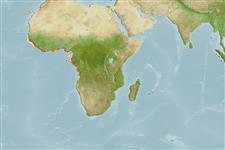>
Eupercaria/misc (Various families in series Eupercaria) >
Sciaenidae (Drums or croakers)
Etymology: Pseudotolithus: Greek, pseudes = false + greek, otos = ear + Greek, lithos = stone (Ref. 45335).
More on author: Bleeker.
Environment: milieu / climate zone / depth range / distribution range
ນິເວດວິທະຍາ
ສັດທະເລ; ນ້ຳຈືດ; ນ້ຳກ່ອຍ ອາໄສຢູ່ໃກ້ໜ້າດິນໃຕ້ພື້ນທ້ອງນ້ຳ; ລະດັບຄວາມເລິກ 0 - 160 m (Ref. 3593). Tropical; 12°N - 17°S
Eastern Atlantic: Guinea-Bissau (Ref. 26999) to southern Angola (Ref. 3593, 81656). Possibly also occurring more to the north (Ref. 81656).
ຂະໜາດ / ນ້ຳໜັກ / Age
Maturity: Lm ? range ? - ? cm
Max length : 60.0 cm TL ຕົວຜູ້/ບໍ່ມີເພດ; (Ref. 3593); common length : 35.0 cm TL ຕົວຜູ້/ບໍ່ມີເພດ; (Ref. 3593)
ຄີ (ໜາມ)ແຂງຢູ່ຫຼັງປາ (ທັງໝົດ) : 10; ຄີຫຼັງຂອງປາ (ຄີອ່ອນ) (ທັງໝົດ) : 35 - 39; ຄີ(ໜາມ) ແຂງຢູ່ຄີກົ້ນປາ
ກຸ່ມປາກະດູກແຂງ
ຄວາມຖີ່ຂອງກຸ່ມຖ່າຍທອດພັນ
ປາທີ່ມີການເຄື່ອນຍ້າຍຈາກທະເລໄປຫານ້ຳຈືດ ແລະນ້ຳຈືດຫາທະເລ
ປາທີ່ມີການເຄື່ອນຍ້າຍຈາກທະເລແລະໄປໄຂ່ຢູ່ນ້ຳຈືດ
ຄີກົ້ນຂອງປາ
ສັດທີ່ມີກະດູກສັນຫັຼງ
ການຖ່າຍທອດທາງກຳມະພັນຈາກພໍ່ແມ່ຫາລູກ: 2; ຄີກົ້ນຂອງປາ: 7. Diagnosis: moderately sized species with an elongate and laterally compressed body; dorsal with 9 (10?) spines in 1st part, second part with 1 spine and 35-39 soft fin rays; second anal spine clearly shorter than first anal fin soft ray, i.e. about half its length, and robust; pectoral fins long, 23.3-27.3% SL; caudal fin S-shaped; mouth inferior almost horizontal; maxilla extending to posterior half of eye; 7-9/1/4-7 (total 13-18) gill rakers on 1st gill arch; lower part of 1st gill arch with 2-6 reduced additional gill rakers, upper part with 0-2 reduced additional ones; gill rakers moderately long and fine, but shorter than the gill filament at angle between lower and upper part of gill arch; preopercular edge feebly denticulated but never with spines; eyes rather small, 4.6-5.4 times in HL, but this character is difficult to use for identification because of allometry (Ref. 81656).
Coloration: generally very dark, but occasionally pale silver often with faint dark brown oblique lines on sides; ventral side of head and belly yellowish; all fins greyish to very dark brown, black (Ref. 81656).
Occurs in coastal waters from the shore to about 70 m over mud bottom, but moves to deeper water. Also found in estuaries and coastal lagoons (Ref. 3593, 81656). Mainly feeds on benthic invertebrates (Ref. 81656).
Life cycle and mating behavior
Maturities | ການສືບພັນ | Spawnings | Egg(s) | Fecundities | ຕົວອ່ອນ
Chao, L.N. and E. Trewavas, 1990. Sciaenidae. p. 813-826. In J.C. Quero, J.C. Hureau, C. Karrer, A. Post and L. Saldanha (eds.) Check-list of the fishes the eastern tropical Atlantic (CLOFETA). JNICT, Lisbon; SEI, Paris; and UNESCO, Paris. Vol. 2. (Ref. 3593)
IUCN Red List Status (Ref. 130435)
Threat to humans
Harmless
Human uses
ການປະມົງ: ເປັນສີນຄ້າ
ເຄື່ອງມື
Special reports
Download XML
ແຫຼ່ງອີນເຕີເນັດ
Estimates based on models
Preferred temperature (Ref.
123201): 19.2 - 27.9, mean 26 °C (based on 102 cells).
Phylogenetic diversity index (Ref.
82804): PD
50 = 0.5156 [Uniqueness, from 0.5 = low to 2.0 = high].
Bayesian length-weight: a=0.00575 (0.00278 - 0.01190), b=3.11 (2.93 - 3.29), in cm total length, based on LWR estimates for this (Sub)family-body shape (Ref.
93245).
ຊັ້ນເຂດຮ້ອນ (Ref.
69278): 3.6 ±0.6 se; based on size and trophs of closest relatives
ຄວາມຢືດຢຸ່ນ (Ref.
120179): ຂະໜາດກາງ, ປະຊາກອນຕຳ່ສຸດທີ່ໃຊ້ເວລາສອງເທົ່າ 1.4 - 4.4 ປີ (Preliminary K or Fecundity.).
Fishing Vulnerability (Ref.
59153): Moderate vulnerability (44 of 100).
Nutrients (Ref.
124155): Calcium = 114 [62, 210] mg/100g; Iron = 0.872 [0.469, 1.499] mg/100g; Protein = 18.7 [17.5, 19.8] %; Omega3 = 0.156 [0.078, 0.287] g/100g; Selenium = 75.1 [39.5, 144.8] μg/100g; VitaminA = 15.5 [6.1, 43.4] μg/100g; Zinc = 1.15 [0.82, 1.64] mg/100g (wet weight);
